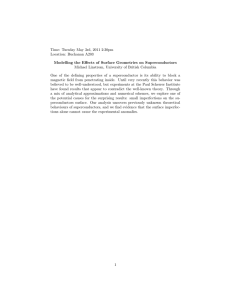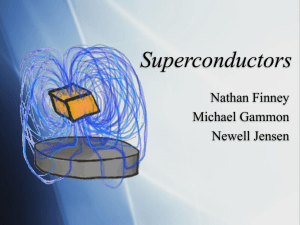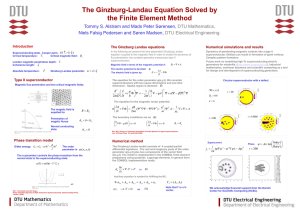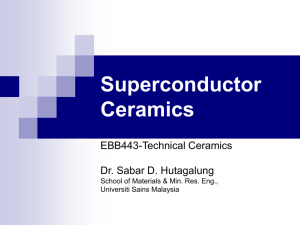5G50.52 Energy Storage with Superconductors
advertisement
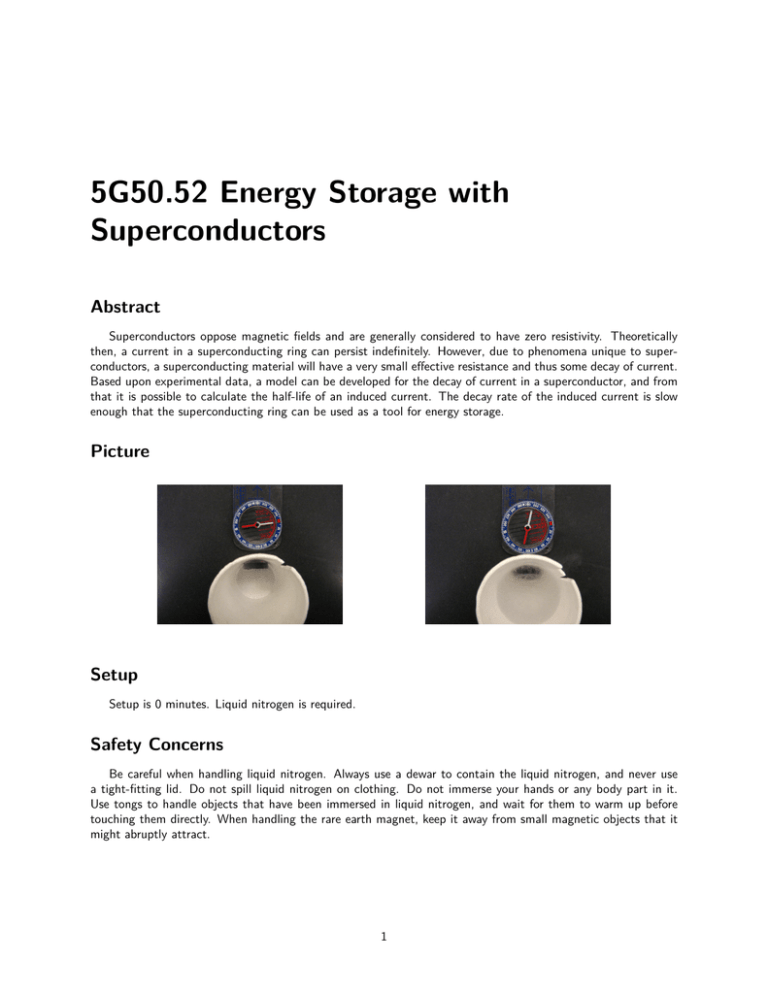
5G50.52 Energy Storage with Superconductors Abstract Superconductors oppose magnetic fields and are generally considered to have zero resistivity. Theoretically then, a current in a superconducting ring can persist indefinitely. However, due to phenomena unique to superconductors, a superconducting material will have a very small effective resistance and thus some decay of current. Based upon experimental data, a model can be developed for the decay of current in a superconductor, and from that it is possible to calculate the half-life of an induced current. The decay rate of the induced current is slow enough that the superconducting ring can be used as a tool for energy storage. Picture Setup Setup is 0 minutes. Liquid nitrogen is required. Safety Concerns Be careful when handling liquid nitrogen. Always use a dewar to contain the liquid nitrogen, and never use a tight-fitting lid. Do not spill liquid nitrogen on clothing. Do not immerse your hands or any body part in it. Use tongs to handle objects that have been immersed in liquid nitrogen, and wait for them to warm up before touching them directly. When handling the rare earth magnet, keep it away from small magnetic objects that it might abruptly attract. 1 Equipment • Superconducting Energy Storage Kit • Styrofoam cup • nduction coil and galvanometer (optional) • Liquid Nitrogen • compass Procedure Place the YBCO toroid in a styrofoam cup so that it is flat with its circular hole parallel to the bottom of the cup. Pour liquid nitrogen into the cup until entire toroid is submerged. More liquid nitrogen may need to be added as it boils. The YBCO toroid will have reached superconducting temperatures when the liquid nitrogen stops boiling. Hold the magnet vertically and bring it close to the bottom of the cup. A slight repulsive force can be felt due to the Meissner current induced in the toroid. The styrofoam cup and toroid can now be brought close to a compass where it will deflect the compass needle. If the styrofoam cup is fillled halfway with liquid nitrogen, the superconductor can be cooled for approximately 15 minutes. The cup will need to be refilled after 15 minutes. It is instructive to induce a current in the induction coil now. The attached galvanometer will register a current reading, then quickly fall back down to zero as the induced current dissipates. By contrast, the superconductor will hold the current so long as it is sufficiently submerged in liquid nitrogen. The superconducting toroid is very sensitive to moisture, so it should be kept as dry as possible while it warms. Specifically, frost will form on the superconductor when it is exposed to air. When the toroid is removed from the liquid nitrogen bath, place it under a desk lamp for a few minutes until it is completely dry and at room temperature. Place all materials back in the storage box, and return all components to the demonstrations room. Theory An electrical conductor is an object through which electricity may flow. Although technically all materials permit current flow under certain conditions, in practice most objects are typified as either conductors (which permit current flow) or insulators (which prevent it). The factor that determines whether an object is a conductor or insulator is its resistance, which depends on both its geometry and the resistivity of its composite material. Resistivity, which varies from material to material, is a more general measure of opposition to current flow because it is independent of object geometry. In a given material, resistivity decreases as temperature decreases. In 1911, Heike Kamerlingh Onnes (1853-1926) discovered that certain metals exhibit zero resistivity at temperatures near liquid helium temperature (4.2 K). Metals that exhibit zero resistivity are called superconductors. It was found in 1986 that ceramics, from a class of materials called perovskites, exhibit superconductivity at much higher temperatures. These temperatures can sometimes reach as high as 90 K or even 140 K. These perovskite materials are classified as high-temperature superconductors, whereas those that require lower temperatures are appropriately known as low-temperature superconductors. The discovery of high-temperature superconductors was important because these temperatures are well above the boiling point of nitrogen (77 K). This meant that liquid nitrogen, which is both less expensive and easier to store than liquid helium, could be used to cool the perovskites sufficiently that they become superconductive. The temperature at which a material becomes a superconductor is known as its critical temperature, Tc , and there are several factors that affect a superconductor’s Tc . The critical temperature of a given superconductor is not only a function of its material composition, but rather it is unique to that particular superconductor. The critical temperature also depends on whether or not any current is flowing through the sample, and whether a magnetic field is present. For instance, a superconductor immersed in a magnetic field will have a lower critical temperature than one that is not. Finally, the critical temperature of a particular sample is also affected by whether or not the sample has many chemical impurities or structural defects. The high-temperature superconductor used in this demonstration is Y Ba2 Cu3 O7 (YBCO). An experimental plot of its resistance as a function of temperature is shown in Figure 2. The sharp decline in resistance seen in the graph is characteristic of all superconductors, and also provides an estimate for the critical temperature of 2 the superconductor. For a YBCO superconductor operating with a current of 0.3 A, the critical temperature is between about 85 K and 88 K. Figure 2: Graph of the experimental resistance of Y Ba2 Cu3 O7 plotted as a function of temperature. For a given temperature of superconductor, there are also other ”critical” values. One is the critical current density, Jc , the maximum current density that can be applied through a superconductor before it loses its superconducting properties. It is important to never apply a current greater than Jc through a superconductor, because the loss of superconductivity is permanent. Just as the critical temperature of a superconductor depends on the applied current and magnetic field, so too the critical current density is dependent upon the temperature and magnetic field of a superconductor at any given point in time. Finally, there is also a critical magnetic field strength, Bc , associated with a superconductor in a given state. The exact value of Bc depends on the temperature of, and current through, the superconductor. It also provides another means of classifying superconductors. In Type I superconductors there is only one value for Bc . Above this field, the sample becomes ”quenched” and loses its superconductive properties. Note that this loss of superconductivity is only temporary, and that superconductivity can be restored simply by removing the field. Type II superconductors are slightly more complex, and must be characterized by two critical magnetic field values, Bc1 and Bc2 . Below Bc1 , the superconductor behaves as a Type I superconductor, resisting all magnetic flux due to a phenomenon called the Meissner effect. Above Bc1 , but below Bc2 , the superconductor enters what is known as a mixed state where there exist some regions in the superconductor that allow the presence of flux. In the mixed state the superconductor retains its overall zero resistivity. Above Bc2 , the superconductor loses its superconducting properties just like with Type I superconductors. The Meissner effect is a phenomenon unique to superconductors whereby they oppose all magnetic flux. When a superconductor is in the presence of an external magnetic field surface currents are induced in the superconductor that generate magnetic fields opposing the external field. The result is that the external magnetic field is cancelled in the superconductor. It is important to note that the Meissner effect is fundamentally different from Faraday’s law of induction. The law of induction describes the opposition in a conductor to a change in magnetic flux, while the Meissner effect is an opposition in a superconductor to any magnetic flux. Figures 3a and 3b shows the YBCO disk in a magnetic field for instances when the YBCO is above and below critical temperature. The magnetic field is free to enter the disk when it is above the critical temperature, but no field can penetrate the disk once it is cooled below its critical temperature. Suppose a current is induced in a superconducting ring. While superconductors are generally regarded as having zero resistance, phenomena unique to superconductors, namely flux flow and flux creep, create a small, effective ”resistance” that causes the current to decay to some extent. Experimental results have determined that an induced current decays exponentially, according to R I = I0 e−( L )t , 3 (1) → − B N et External → − B N et External Superconductor Superconductor (a) Above Tc . (b) Below Tc . Figure 3: Diagrams of a superconductor above and below the critical temperature, Tc , within an external magnetic field. where I is the current present at a time t, I0 is the initial induced current, R is the effective resistance of the superconductor, and L is the inductance of the superconductor. In this demonstration, a rare earth magnet is used to induce a current in the toroidal YBCO superconductor. When the magnet is moved near the toroid, surface currents are initially induced in the superconductor due to the Meissner effect (these are often called ”Meissner currents”). If the magnet is brought close enough such that its field strength exceeds the first critical field of the superconductor, the toroid enters the mixed state and the magnetic field can penetrate certain regions of the toroid. When the magnet is moved away from or closer to the toroid, these regions are subject to electromagnetic induction, which generates currents in these regions (these can be considered ”Faraday currents”). The net current in the superconductor is the sum of the Meissner currents and the Faraday currents. Analysis of the rate of decay of the current is discussed the a paper by Fuhan Liu, Rochelle R. Tucker and Peter Hellerby in their paper ”Nitrogen Temperature Superconducting Ring Experiment”. From this analysis it has been determined that half life of the current can be up to 1023 years. Since the decay rate of the induced current is so slow, the induced current is considered to be permanently stored as long as the toroid is kept at superconducting temperatures. To show the existence of this induced current, the toroid with the induced current can be brought near a compass where the magnetic field from the induced current deflects the compass needle. The toroid will continue to exhibit this behavior if it is kept at the appropriate temperature. By contrast, an induction coil with an attached galvanometer can be used to show the quick dissipation of an induced current in copper wire. When the magnet is used to induce a current in the coil, the galvanometer registers a current reading but the reading then promptly falls back to zero, indicating the current has dissipated. 4 References [1] Freericks, J. K. Colorado Superconductors Inc., Experiment Guide for Superconductor Demonstrations, Version 7.0, May 2007. pg 6-7, 29-33. [2] Khurana, Anil et al. ”Electron Superconductors Challenge Theories; Start a New Race”, Physics Today, Vol 42, April 1989. pg 17-19. [3] Fuhan Liu, Rochelle R. Tucker, and Peter Heller. ”Nitrogen Temperature Superconducting Ring Experiment”, American Association of Physics Teachers, Vol 58, March 1990. pg 211-218. 5
